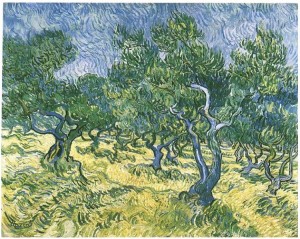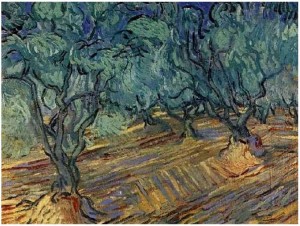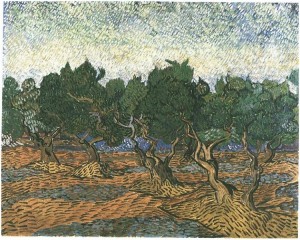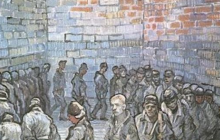Van Gogh spent a year living in the asylum at Saint Remy de Provence. Though it was a turbulent time in his life it was a very prolific one artistically. Van Gogh created numerous paintings, frequently turning his attention to the land outside the asylum. During this time he created a series of at least 15 paintings of olive trees.
Van Gogh found beauty in the olive trees, he wrote to Theo at the end of April, 1889 and said,
“Oh, my dear Theo, if you saw the olives just now…The leaves, old silver and silver turning to green against the blue. And the orange-coloured ploughed earth. It is something quite different from your idea of it in the North, the tender beauty, the distinction!
…the rustle of an olive grove has something very secret in it, and immensely old. It is too beautiful for us to dare to paint it or be able to imagine it.”

Van Gogh found painting olive trees to be a difficult and complex task. He wrote to his friend Emile Bernard c.October 8, 1889 and spoke of the challenge,
“The olive trees here, old man, would be the very thing for you. I haven’t had much of a chance to get them right this year, but I intend to return to the charge; they are silver against a soil of orange and violet hues, under the large white sun. Good Lord, I have seen things by certain painters, and by myself too, which did not do justice to the subject at all. In the first place there is something of Corot in that silvery grey, and this especially no one has done yet, whereas several painters have got their apple trees, for instance, and their willows right.”

On June 16, 1889, he wrote Theo about a landscape of olive trees,
“I have just finished a landscape representing an orchard of olive trees with grey leaves, somewhat like those of the willows in colour, their violet shadows lying on the sunny sand.”

Some of his olive tree paintings were done in response to recent works he had seen by his friends Paul Gauguin and Emile Bernard. He didn’t care for their compositions and found them lacking and frustrating. He told Theo,
“The thing is that this month I have been working in the olive groves, because their Christs in the Garden, with nothing really observed, have gotten on my nerves.”
…
“Well, to shake that off, morning and evening these bright cold days, but with a very fine, clear sun, I have been knocking about in the orchards…”
…
“Now the olive and the cypress have exactly the significance here as the willow has at home. What I have done is a rather hard and coarse reality beside their abstractions, but it will have a rustic quality, and will smell of the earth.”

Letter Sources:
http://www.webexhibits.org/vangogh/letter/19/587.htm
http://www.webexhibits.org/vangogh/letter/20/B20.htm
http://www.webexhibits.org/vangogh/letter/20/W12.htm
http://www.webexhibits.org/vangogh/letter/20/615.htm



Van Gogh is one of my favorite artists, and his landscape paintings are the one I appreciate the most.
The paintings of olive trees makes me think about “The nap”, that is also exhibited in Paris, I actually had the chance to see it for real since I live in France.
We know that during these years, Van Gogh was mentally ill and painted a lot, about a painting per day. It can thus be considered a particularly prolific (as you said) and creative period for him, which happened just before his death.
He masters nature and depicts it with passion and delicacy, we can almost feel the wind through his paintings, when seeing the trees and the leaves. The reason why I love his art so much is that he knows how to make it alive.
Pauline Teulier, graduation May 2018,
Freeman business school, Tulane University
Essex business school